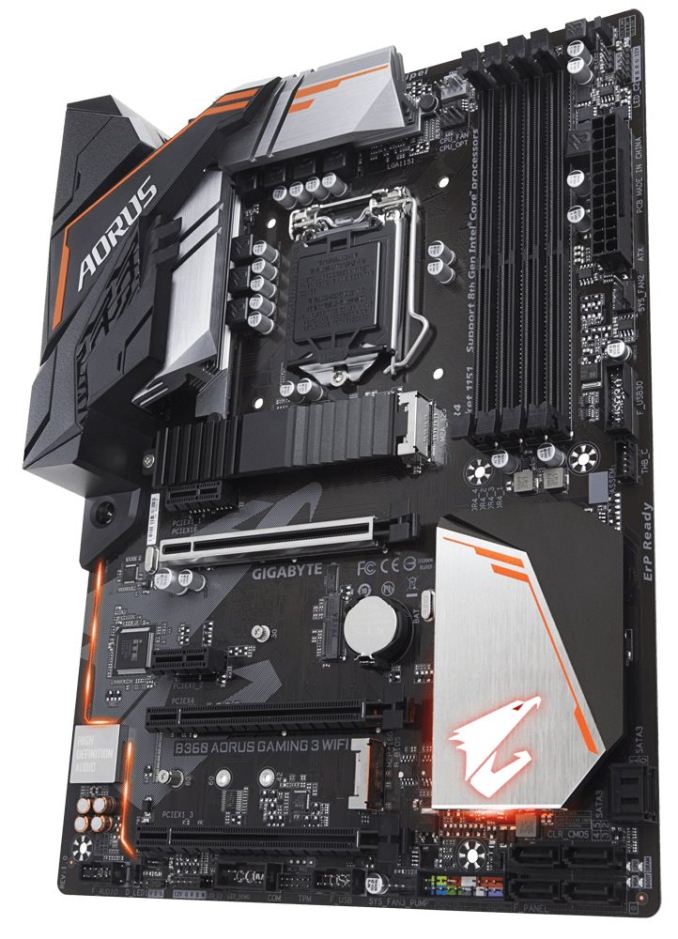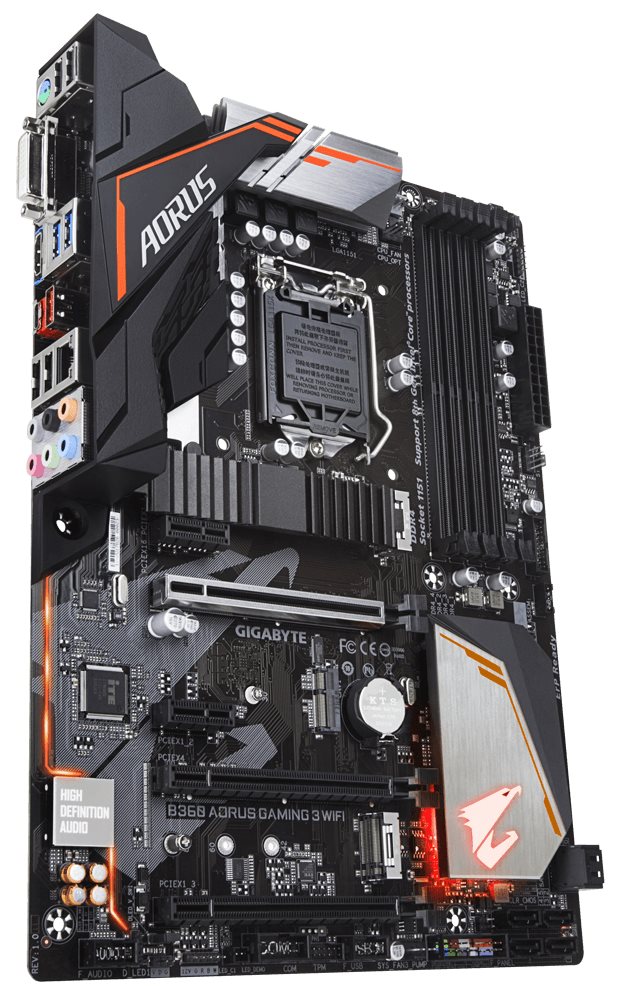The GIGABYTE B360 Gaming 3 WIFI Review: A Cheaper Alternative at $120
by Joe Shields on July 11, 2018 9:45 AM ESTConclusion
For users who are not looking into paying the premium for a K-series unlocked processor, or a Z370 based motherboard, the B360 chipset offers that opportunity to get into the platform at a lower price point. The GIGABYTE B360 Gaming 3 WIFI at $120 presents users with most all the connectivity a user may need while being able to save a few dollars. When buying, think critically about the chances of overclocking in the future or another CPU and/or motherboard will have to be purchased. If never overclocking is the answer, in the end, this chipset can provide a board for your needs.
Many of the features of the "Z" motherboards carry over here to the B360 Gaming 3 WIFI, with a couple of extra ones as well. The board has the full complement of six SATA ports and also has two M.2 slots (one w/heatsink) that support both PCIe and SATA modules for a fast storage and mass storage needs. There is a 5-pin Thunderbolt header on the board for TB3 support, an audio separation line, and audio caps, as well as a reinforced PCIe slot. If RGB lighting is your thing, we saw the two locations as well as multiple RGB LED (including digital) headers on board for expansion. The board also includes a single USB 3.1 (Type-A) port out back.
The unique feature, compared to Z370, is the integrated Intel CNVi Wi-Fi on board. These new chipsets (H370, B360, H310, Q370) all have the CNVi Wi-Fi built right into the chipset. This means there are no third party controllers needed. When bundled with a companion CRF module (which has an estimated $15 extra final cost), the device attaches to the M.2 slot between the top and 2nd full-length PCIe slots. The Wi-Fi is 802.11ac supports Wave 2 and runs at 160 Hz which yields a maximum bandwidth of 1.73 Gbps. Most Z370 boards do not support that speed out of their integrated Wi-Fi, and none have it integrated on the chipset. With this comes a higher level of Bluetooth support (Bluetooth 5.0).
After looking over the board, there really wasn't much to complain about. I have some preferences of what I would like to see, but I am reminded this is a B series board, not intended to carry everything over from the more expensive platform. With that in mind, I still would have liked to see a hinged heatsink on the M.2 module. As it stands now, it is screwed down at the end and at the base is a tab that slips out easily when not screwed down. I would also prefer the SATA ports all oriented in the same direction since it has the real estate, but, then again, this may be my OCD kicking in. There's also the use of the cheaper Realtek ALC892 codec, which is a factor of a cheaper motherboard.
When talking performance, the motherboard performed admirably, but not impressively. Its results were in the range of others, but never leading, except for power consumption, and sometimes going behind, such as in WinRAR or in DPC Latency.
In the end, the B360 AORUS Gaming 3 WIFI has the vast majority of features many PC users need. Whether it is for gaming or office work and productivity, the board offers users lightning-fast Wi-Fi capabilities, USB 3.1 port, as well as dual M.2 slots for storage purposes. About the only thing it can't do is overclock, which is to be expected on this chipset.
The board's direct competition from a price perspective is the ASRock B360 Gaming K4 ($118), ASUS ROG Strix B360-H Gaming ($115), and an MSI B360 Gaming Arctic ($125). Less than $10 separates these boards from each other price wise, with the main differences found in SATA port and M.2 socket counts, PCIe x1 slots as well as video outputs and USB support. Obviously, there are design aesthetics that can sway a decision one way or another, but that is about the gist of it. GIGABYTE has brought forth a solid board with a lot of features at a reasonable price with which to build a system around.
AnandTech Intel 300-Series Motherboard and CPU Coverage
- The Intel Core i7-8086K Review: Testing Intel's Anniversary 5.0 GHz Turbo CPU
- The Anandtech Coffee Lake Review: Initial Numbers on the Core i7-8700K and Core i5-8400
- Analyzing Z370 for Intel's 8th Generation Coffee Lake: A Quick Look at 50+ Motherboards
- ($397) The ASUS ROG Maximus X Apex Review [LINK]
- ($250) The NZXT N7 Z370 Review [LINK]
- ($191) The SuperO C7Z370-CG-IW Review [LINK]
- ($180) The ASUS Z370-I Gaming Review [LINK]
- ($124) The GIGABYTE H370N WIFI Review [LINK]
- ($120) The GIGABYTE B360 Gaming 3 WIFI Review (this review)












18 Comments
View All Comments
drw28 - Wednesday, July 11, 2018 - link
can you review the gigabyte UD pro drives?the combination of phison s10 and toshiba's bics nand would be interesting to see.peevee - Wednesday, July 11, 2018 - link
There used to be you could get a decent ATX MB for the latest mainstream CPU for around $50. What happened? Is it Intel overpricing their chipsets?imaheadcase - Wednesday, July 11, 2018 - link
In what world did you visit to get that cheap..i think you are mistaken.DanNeely - Wednesday, July 11, 2018 - link
In aggressive sales perhaps. Otherwise, while I recall seeing an occasional $50 board; the reviews always indicated that there was something wrong with them. Either from a company known to only build garbage (eg PC Chips, ECS before they figured out how to make good products, or a few other companies who're dead and forgotten) or an occasional screwed up board from a mainstream brand. I remember getting an ASUS S939 board for maybe $60 years ago, when it crapped out and I looked at reviews I turned out that I wasn't alone, something like 50% 1/2 stars from people whose boards had died on them.The True Morbus - Thursday, July 12, 2018 - link
I think there used to a PERCEPTION that you could get a decent board for 50 bucks, but that's probably because most 150$ boards looked similar to most 50$ boards.You can still buy the 50$ boards if you want. They'll be the first thing to give out in the build, you can write that down. And no, it doesn't matter if they're from a famous brand, they'll likely give out even quicker if that's the case.
PeachNCream - Thursday, July 12, 2018 - link
The last $50 motherboard I purchased was a Gigabyte GA-F2A68HM-HD2 which was a FM2 socket mATX board. The SATA connectors all failed at the same time about three months after I bought it. There was a DVD drive on one and a 1TB WD hard drive on another when it gave up and stopped detecting devices. I tried a few other drives, shuffled ports around, got new cables, etc and the hard drive worked in an external case just fine (still is working in fact). It wasn't worth the trouble to go through customer support for RMA, but it was a bit annoying. That was the last time I wasted effort on a desktop of any sort and PC games for the most part as well. Glad to be done with that particular disaster after multiple decades of chasing system requirements. Cell phone gaming FTW!peevee - Thursday, July 12, 2018 - link
My last personal builds were in 2000 (on ASUS) and 2011 (ASRock). Never failed. Maybe they were 50-something.peevee - Thursday, July 12, 2018 - link
The latter is the Z68 board I still use. With then brand-new top-of-the-consumer-line i7-2600k.Still OCZ Vertex 3 256GB bought for $500 then, still works (although until they have fixed its firmware about a year later it had troubles). Now THAT one still alive is a surprise.
Galcobar - Wednesday, July 11, 2018 - link
Some copy editing might be in order. Aside from the raft of grammatical errors (e.g. worth vs worthy of), random commas and typos (e.g. B350, i7-8400), specifications are contradictory.For example, page 1: "... a total [of] four USB 2.0 ports, three USB 3.0 ports (one Type-C), and one USB 3.1 (10 Gbps) port (red Type-A)."
Page 2: "USB 2.0 (4x ports), USB 3.0 (3x ports) and a USB 3.1 Type-C port"
Also, when did Anandtech switch (back) to referring to USB 3.1 Gen 1 and Gen 2 as, respectively, USB 3.0 and 3.1? Five days ago it was the former.
Joe Shields - Wednesday, July 11, 2018 - link
The typo mentioned RE: USB was corrected. Thank you for catching that.As far as the 'switch'.... I know in my reviews, at least the past dozen or two, I have been referring to it in this manner consistently AFAIK. Prior to that I would use something like "USB 3.1 (speed here)" to clarify.